Abstract
This research focuses on the optimization of formulation, characterization, and damage analysis of plant fiber-reinforced polyester resin composites (jute and date palm). To better understand the characteristics and mechanical behavior of these materials, this study investigates the influence of resin content and plant fibers on the physico-mechanical behavior of the resin composites. Resinous composites consisting of polyester resin and raw earth were studied using a novel formulation based on an empirical method that follows the principle of earth saturation with polyester resin. Saturation was achieved with a 28% content of polyester resin, which appeared to be an optimal blend for the earth–resin composite. Plant fibers were randomly incorporated as reinforcement in the composites at various percentages (1%, 2%, and 3%) and lengths (0.5 cm, 1 cm, and 1.5 cm). Mechanical tests including bending, compression, and indentation were conducted to evaluate the mechanical properties of the composites. Analysis of fracture morphology revealed that the deformation and rupture mechanisms in bending, compression, and indentation of these composites differ from those of traditional concrete and cement mortar. The obtained results indicate that the composites exhibit acceptable performance and could be favorably employed in the rehabilitation of historic buildings.
1. Introduction
The quantity, storage, and incineration of waste from different sources, which are constantly growing, threatening the ecology and health of living beings, are of concern to the world society [1]. The only way to solve this problem is to increase the recovery and recycling of these products [2]. Indeed, many works encourage the return to biodegradable ecological materials, not energy consuming and based on renewable energies [3].
Kalak T et al. [4] conducted a study focusing on the prospective utilization of industrial biomass waste as a sustainable energy source for the future. They explored various conversion technologies and their potential applications to harness these biomass wastes for energy production. Their research emphasizes the critical importance of sustainable energy solutions and waste management practices in addressing environmental and energy-related challenges.
Moshood D et al. [5] performed a thorough investigation into biodegradable plastics. They aimed to understand their production, various applications, sourcing aspects, and ecological impact. Additionally, the study analyzed the complex factors influencing the adoption of biodegradable plastics and proposed a carefully crafted sustainable framework to enhance their long-term viability and environmental friendliness.
In the field of civil engineering, the recovery of local waste and by-products from industry and agriculture in the development and characterization of building materials has been the subject of several studies.
Rahim o et al. [6] studied the influence of replacing cement with the by-products granulated slag waste and silica fumes to improve the physico-mechanical properties of high-performance cementitious composites. They concluded that the use of these additions is very beneficial in reducing environmental problems and improving the durability of cementitious composites.
According to Bourbia S et al. [7], materials of biological origin such as hemp, wood, date palm wood, cork, esparto, and straw exhibit significant potential for use in building envelope applications, with the aim of enhancing energy efficiency during their lifecycle. These materials possess distinct advantages, including renewability, low embodied energy, neutral or negative CO2 impact, and excellent thermal regulation properties.
Marczak et al. [8] developed an effective method for managing fiber waste that offers the possibility of manufacturing innovative and ecofriendly materials while respecting circular economy objectives and user expectations. They discovered that waste fibers provide the basis for innovative soil water storage technologies in the form of biodegradable water-absorbing geocomposites.
Biskri Y et al. [9] contributed to optimizing the formulation of the sand-based cementitious composite as part of the recovery of plastic waste extracted from polyethylene terephthalate bottles and packaging tapes. The experimental results of this study show that reinforcing the cement matrix with PET fibers improves the physico-mechanical properties of the composite.
Aboutair W et al. [10] demonstrated that the use of fibers from crimped steel improves the mechanical characteristics of cementitious composites as well as their durability.
All this research has led to satisfactory results from an economic and ecological point of view. These materials are not always intended for the load-bearing structure, but as masonry elements used to fill exterior walls and partitions, or else insulating materials, light materials and materials for the rehabilitation of the old building [11,12].
Among other things, earth and clay are the most abundant materials on our planet. These materials have been used since ancient times in civil construction. Great ancient constructions belonging to different civilizations throughout the world have been preserved and maintained to date and are the subject of great interest in the world of the ongoing search for a healthy life in a biological and biodegradable environment [13]. This process aims to preserve the historical and cultural character of these buildings while improving their durability, structural stability and ease of use [14,15].
Algeria is a vast country with a rich array of historically and culturally significant architecture. These buildings require rehabilitation and maintenance in order to preserve this architectural heritage [16,17]. The rehabilitation project of Timimoun, Adrar (southern Algeria), was carried out by the Algerian center for cultural heritage, built in CAPTERRE land. The realization of this project was entirely made by natural products of local origin: sand, clay, date palm and the reuse of the rubble from the old building [18]. The use of these recycled materials allows these buildings to retain their natural appearance, characteristics and color [19].
The incorporation of plant fibers into raw earth exhibits several notable enhancements in material behavior. Reinforcement with these fibers tends to improve the strain energy and yield to ductile behavior in bending and compression as well as reducing the conductivity.
Mabrouk Y et al. [20] studied the influence of waste from hemp for the manufacture of rammed earth. They found that the addition of hemp improves the mechanical performance of the rammed earth and its thermal properties, linked to the thermodynamic behavior of the building in terms of efficiency and durability.
Tarhan y and Perrot A [21] highlight the positive impact of reinforcing earth-based composites with natural jute fabric textiles, resulting in a structural material with improved compressive strength, good tensile strength and ductile behavior.
Fattahi M et al. [11] showed that the use of waste corn husk fibers as sound absorption and thermal insulation materials has aroused great interest with excellent noise-reduction coefficients and conductivities.
The incorporation of polyester resins into mortars and composites signifies a notable breakthrough in the realm of construction materials, with a particular focus on applications related to structural repair and rehabilitation [22]. These hybrid composite materials, arising from the amalgamation of polyester resins with other matrices and fibers, present distinctive prospects for enhancing crucial attributes of construction materials, including strength, durability, flexibility, and various other fundamental properties [23,24]. The increasing attention directed toward this approach arises from the persistent pursuit of energy-efficient, sustainable, and resilient building solutions within the construction industry [25].
The objective of this study concerns the experimental optimization of an eco-material based on raw earth stabilized by a water-repellent binder and reinforced with plant fibers intended for the rehabilitation of enclosures built in earth. Indeed, the vulnerability of old earthen architectures results from negligence with regard to maintenance and sometimes from poor rehabilitation which does not take into consideration the adequacy of the association of an old material with the cementitious materials. Therefore, it is essential to take into account the specific characteristics of the materials used as well as the construction techniques during the rehabilitation. This guarantees a respectful approach to the architectural and cultural heritage while offering appropriate technical solutions to meet current safety standards and guarantee ecological, economic, environmental, and socio-cultural comfort.
For the elaboration of the composites, the local raw earth was used as a base material reinforced by the vegetable fibers of date palm and jute, which were used to provide certain ductility and prevent cracking of the product. Polyester resin was used as a binder to guarantee the water-repellent nature of the earth composite and increase the mechanical resistance, which gives it excellent adhesion between the matrix and the fibers, resistance to chemical attacks and a reduced drying time. To guarantee the efficiency of the material selection, several tests were carried out on test specimens to achieve an optimal bio-sourced and energy-efficient formulation.
2. Materials and Experimental Approach
2.1. Materials
2.1.1. Raw Earth
The raw earth studied comes from the region of Seraidi, Annaba, north-eastern Algeria. This soil was used historically for the construction of adobes. It is a fine-grained clay-sandy soil. The characteristics of the raw earth used and the particle size curve are represented, respectively, in Table 1 and Figure 1. The experimental tests were carried out at the laboratory level (LMGE-Annaba) following the methodology outlined by Bekkouche, S.R et al. [26].

Table 1.
Characteristics of the soil used.
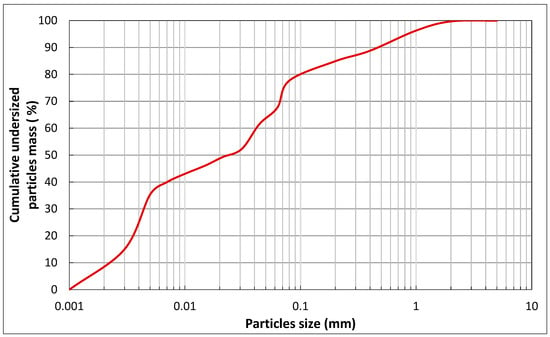
Figure 1.
Size analysis of the soil used.
2.1.2. Polymer
The polymer used is a liquid polyester resin requiring an additive whose role is a hardener supplied in the colorless liquid state. The characteristics of this resin are mentioned in Table 2.

Table 2.
Characteristics of the polyester resin used.
2.1.3. Plant Fibers
For the reinforcement of the elaborated composites, two vegetable fibers were used separately. These are jute fibers and date palm fibers.
Jute Fibers
In this study, the jute fibers used were extracted from jute bags recovered from the dried vegetable market in the city of Annaba. The jute bags were washed and cut into fibers at different lengths. Energy dispersive spectrometry (EDS) coupled to SEM allows the determination of the chemical composition of the examined surface, as shown in Figure 2 and Figure 3. The characteristics of the fibers are detailed in Table 3.
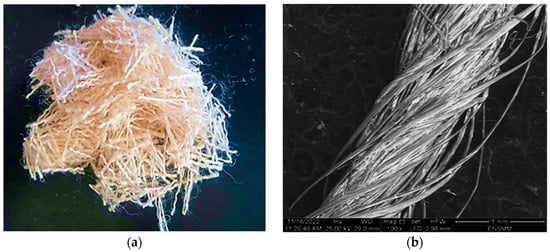
Figure 2.
Jute fibers: (a) cut fibers; (b) SEM observation.
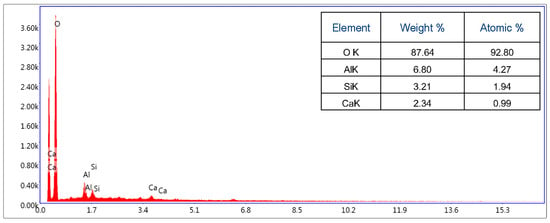
Figure 3.
EDS of jute fiber.

Table 3.
Physico-chemical and mechanical properties of the fibers used.
Date Palm Fibers
This study relates only to the fibers extracted from the leaflets of the date palm trees. The date palm fibers tested originate from the Biskra region (Algeria). The date palm leaflets were dried in the air under the sun then washed with plenty of tap water to remove dust, then they were dried in the oven. Their ends were cut and the remains were shredded to have more or less uniform long fibers. The cutting of the fibers was performed in a shredder with parallel cut knives. The length of the fiber depended on the shredding speed (adjustable) [26,36] (Figure 4). Energy-dispersive spectrometry (EDS) coupled to SEM is illustrated in Figure 5. Fiber characteristics are summarized in Table 3.
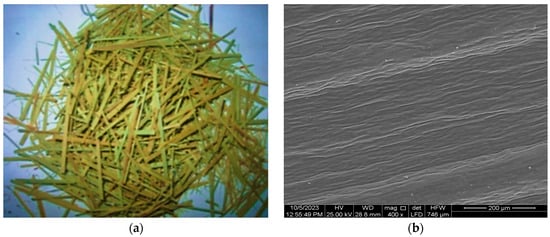
Figure 4.
Date palm fibers: (a) cut fibers and (b) SEM observation.
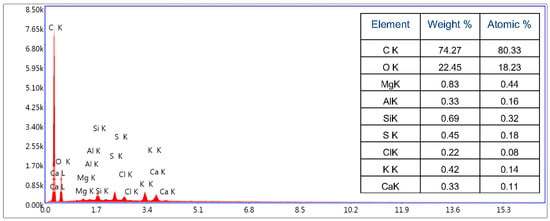
Figure 5.
EDS of date palm fiber.
The method used to determine the tensile strength of fibers is based on the experimental protocol used by Benzerara et al. [16] and Derdour et al. [37], adapted to the study of single ultimate fibers. Fiber cross-sections were measured using an optical microscope, as shown in Figure 6a. Subsequently, the fibers were attached to a hollow paper support, as shown in Figure 6b. Once prepared with their paper support, the fibers were attached to a direct tensile testing machine, as shown in Figure 7.

Figure 6.
Tensile strength measurements: (a) sample preparation; (b) measurement of fiber diameters using optical microscope imaging and (c) tensile loading machine.
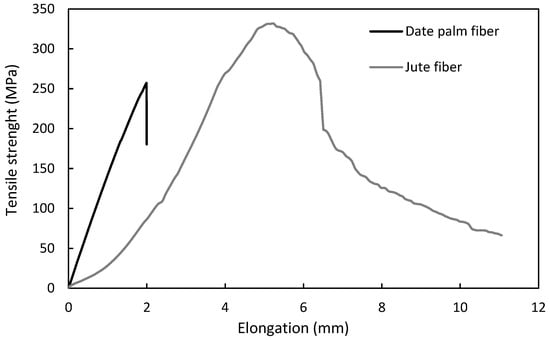
Figure 7.
Tensile curve of jute and date palm fibers.
Figure 7 depicts the stress–elongation curve derived from direct tensile testing conducted on individual date palm and jute fibers. The results indicate that date palm fibers exhibit a linear elastic response, characterized by a maximum breaking stress of 263 MPa and a corresponding elongation of 2.37%. These fibers demonstrate an elastic modulus of 130 GPa, indicative of brittle fracture behavior. Conversely, jute fibers, composed of microfibrils, display a ductile response, owing to the sequential breakage of microfibrils under increasing tensile loads. Jute fibers exhibit a tensile strength of 345 MPa, an elastic modulus of 70 GPa, and a unit elongation at break of 8.55%.
2.2. Mixture Design
The formulation approach that was used to make the different mixtures in this study is an empirical method developed from an experimental methodology based on the saturation point of the earth with the resin. The value of the resin content is set according to the saturation necessary to obtain a compact and manageable paste. The general principle of determining the optimum resin content by mass substitution of the soil is adopted by gradually increasing the resin dosage in steps of 2%, starting with a rate of 10% in the fresh state.
Three extreme changes are distinguished in the development of the various composites: at 10% and 12% resin: a dry mix; the adhesion between the constituents of the composite is insufficient, and the mixes are difficult to handle and friable (Figure 8a). From 20 to 28% resin: the workability of the mixtures is increasingly improved, and the adhesion between the constituents of the composite is highlighted in the fresh state (Figure 8a,b). Nevertheless, a liquid paste was obtained, indicating oversaturation of the earth at the rate of 30% resin (Figure 8c).
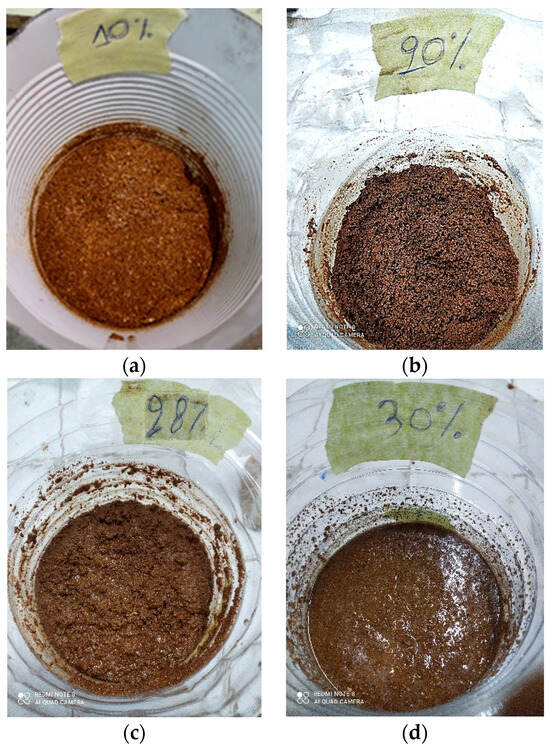
Figure 8.
Fresh state of mixtures with: (a) 10% resin; (b) 20% resin; (c) 28% resin; (d) 30% resin.
In the first stage, it is evident to eliminate composites with resin contents of 10%, 12%, and 30%. The choice of resin content was thus set at 28% in order to guarantee the optimal coating of the earth material [38]. The reinforcement of the composites studied by plant fibers was carried out to prevent cracking of the elaborated material. In this research, two fibers were used separately: jute fiber and date palm fiber. The introduction of these fibers is performed randomly using mass substitution of the earth at rates of 1%, 2% and 3%.
2.3. Experimental Methods
Before proceeding with the fabrication of the composites, preliminary steps are necessary. The constituent materials are stored under favorable conditions. The earth is dried at 60 °C for 48 h [16]. The polyester resin and the hardener are stored in a temperature-controlled conservator. The manufacture of the specimens is carried out according to a process beginning with the preparation of the binder: a mixture of the polyester resin and the hardener, whose dosage is adjusted to the percentage of resin; it is set at 2.4% according to the study by Mirouzi et al. [38]. It consists of mixing the earth with an optimal water content determined by the proctor test by the prepared binder. The mixture is mixed for 3 min to avoid sudden crystallization. The filling of the mixtures in metal molds is carried out in 3 layers by vibration for 2 min. The samples are stripped after drying in the surrounding area under laboratory conditions at temperature T = 25 °C and relative humidity RH = 50%) for 24 h (Figure 9).
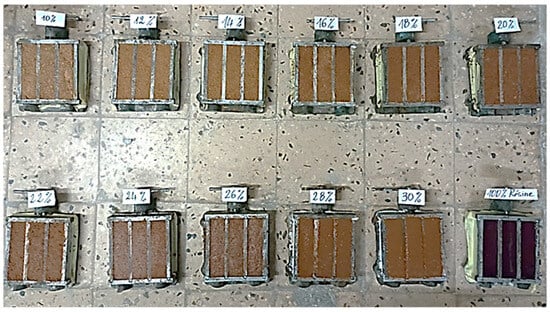
Figure 9.
Preparation of the composites obtained in the molds.
Two types of specimens are used for the mechanical tests: prismatic specimens of dimensions 40 × 40 × 160 mm3 in accordance with standard NF EN 12390-1 (2001) [39] for the three-point bending tensile test according to standard NF EN 12390-5 (2019) [40]. This test was carried out on a bending machine with a capacity of 20 kN, equipped with a specific three-point bending assembly. The half-samples obtained after the bending test are reintroduced into a suitable metal device fitted with standard steel plates to regulate the crushing surfaces 40 × 40 mm2 in contact with the plates of the compression machine with a compression capacity of 2000 kN for compression tests according to standard NF EN 12390-3 (2000) [41]. This procedure is adopted in order to have specimens manufactured and molded under the same conditions for the two types of stress [38].
The indentation test consists of applying a load to a pyramid-shaped indenter on the surface of the material to be tested under the action of an increasing load up to the target value [42], as shown in Figure 10.
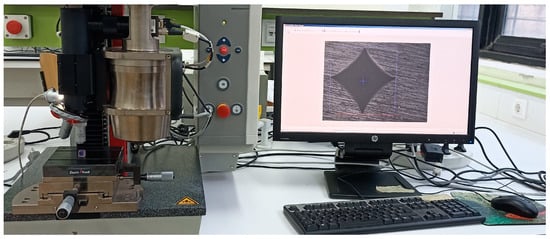
Figure 10.
Settings of Vickers indentation test (LRF Laboratory—UBMAnnaba, Algeria).
The test consists of driving the indenter into the material, producing deformations in the contact zone on a microscopic scale, which can be elastic and (or) plastic. As soon as the maximum fixed load is reached, the indentation force is maintained for the time chosen by the operator (15 s). The measured load is then gradually reduced until partial or complete relaxation of the sample occurs. Load and displacement are recorded continuously throughout this process to produce a load–displacement curve. At the end of the test, a residual footprint visible under the microscope is recorded. The Vickers force was employed to gain insights into the mechanical properties and mechanisms contributing to the brittleness of the studied composites. This test also enables the determination of the elastic modulus (E). The Vickers hardness by the relationship according to the standard NF EN ISO 6507-1 (2018) [43]:
HV: Vickers hardness;
F: strength;
S: area of the footprint;
d: middle diagonal;
α: angle of the indenter pyramid.
It is the empirical relationship that allows for the conversion from hardness to the mechanical resistance of plastic deformation, ultimately resulting in the residual imprint on the material’s surface. The reduced modulus of elasticity of the material, as well as its hardness, are determined from an indentation curve following a standardized procedure NF EN ISO 14577-1 (2015) [44].
3. Results and Discussion
3.1. Influence of Resin Content on the Physico-Mechanical Characteristics of Composites
Figure 11 illustrates the effect of the resin content on the physico-mechanical properties of the composites examined. This influence is manifested by a notable increase in compressive and tensile strengths in bending. It is interesting to note that the growth of these resistances seems to follow an almost linear trend with respect to the variation in the resin content. As the resin content increases, there is a reduction in material density, which results in improved mechanical performance. For example, the compressive strength increases significantly, increasing from 8.7 MPa for the composite containing 14% resin to 52.67 MPa for the one with 28% resin.
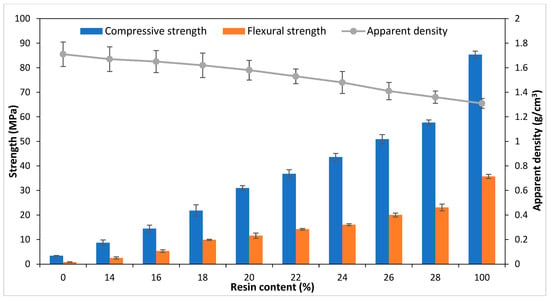
Figure 11.
Influence of resin content on density, compressive strength and flexural strength of the composites studied.
Regarding the flexural strength, the values vary from 1.49 MPa for the composite with 14% resin to 19.07 MPa for that with 28% resin. However, it should be noted that the density of composites decreases as the resin content increases. This behavior can be attributed to the filling of the voids between the soil particles by the infiltration of the resin, which results in the clogging of the pores and, consequently, a decrease in the density of the material. This explanation also justifies the higher density observed in the material composed of 100% resin, due to the use of the same vibration conditions as those applied to other composites, consisting of both earth and resin.
3.2. Influence of Fibers Addition
The composite with the optimal resin content (28%) was reinforced with fibers using mass substitution, the content of which was fixed at values of 1, 2 and 3% with the lengths 0.5, 1 and 1.5 cm. The addition of fibers to the optimal formulation is essentially performed to prevent cracking of resin composites tested in three-point bending and compression.
3.2.1. Influence of Fibers Content and Length on Composite Density
Figure 12 shows the results of the variation in the density of the composites as a function of the lengths and contents of plant fibers used. It is observed that the density of composites reinforced with date palm fibers is generally lower than that of composites reinforced with jute fibers. This converges with the porous state of these date palm fiber composites. This porosity can be attributed to the rigidity of the date palm fiber, which can entrain air in the matrix during the mixing of the material in the fresh state. The jute fiber being soft and flexible does not prevent good mixing and compaction of the composite. This reduces the porosity by increasing the density.
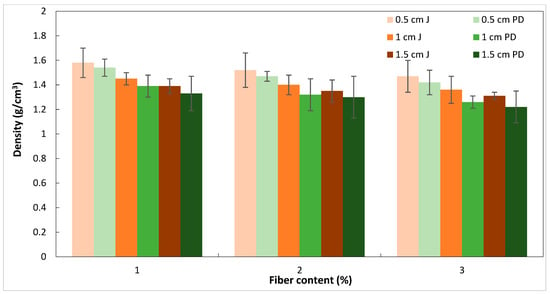
Figure 12.
Influence of fiber content and length on composite density.
3.2.2. Influence of Fiber Content and Length on Compressive Strength
Figure 13 shows the influence of fiber content and length on the compressive strength of the composites studied. It is found that for the length of the fibers of 0.5 cm, the compressive strength goes from 41.02 for the fibered jute composites to 37.85 MPa for the fibered palm composites in the case of the 1% fiber dosage. For the same length (0.5 cm), this resistance increases, respectively, from 33.54 to 30.11 MPa at a fiber content of 3%. Hence, a drop in stress of around 7.73% for the jute fiber against a low of 10.23% for the palm fiber. This highlights that the short fiber lengths create a better bond in the material to give high compressive stresses.
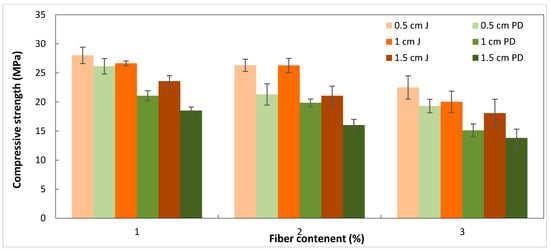
Figure 13.
Influence of fiber content and length on the compressive strength of the composites studied.
A decrease in compressive stresses with the addition of fibers and the increase in their content and length is observed. For a content of 1%, the falls are lower than for the other contents.
Towards the 2 and 3% fiber percentages, the compositions containing jute fibers gave high compressive stresses compared to the compositions containing date palm fibers. This is explained by the morphology of jute fibers, which is completely different from that of palm fiber (Figure 5 and Figure 7).
It is noted that the compressive strength is inversely proportional to the fiber content on the one hand and that the composites reinforced with jute fibers perform better than those reinforced with date palm fiber on the other hand. This can be attributed to the flexibility of the jute fiber, which opposes the entrainment of air during the mixing of the material and the filling of the molds, which ensures a less porous material.
3.2.3. Influence of Fiber Content and Length on Bending Tensile Strength
Contrary to the behavior in compression, the compositions containing the various contents and lengths of fibers see their bending stresses increase with the increase in the lengths and the contents of fibers. Jute fiber with a length of 1.5 cm gives high tensile bending stresses compared to other compositions.
Figure 14 illustrates the results of the three-point bending tests of the composites as a function of the lengths and the fiber contents used. At a fiber content of 1% and for a length of 0.5 cm, the stress is reduced from 12.08 MPa for the composite reinforced with jute fibers to 11.01 MPa for that reinforced with palm fibers. This trend continues when increasing the length to 1.5 cm and the fiber content to 3%, where the stresses increase from 24.31 to 20.87 MPa for the jute and palm-fiber-reinforced composites, respectively. These observations reveal that the 1.5 cm lengths promote increased bonding within the material, resulting in higher levels of tensile bending stress.
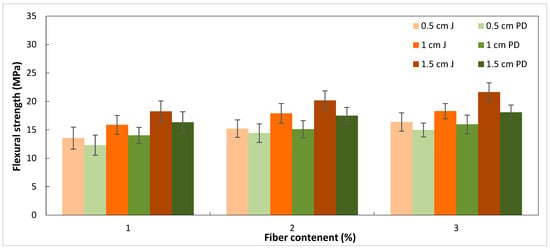
Figure 14.
Influence of fiber content and length on the bending tensile strength of the composites studied.
3.3. Failure Modes
3.3.1. In Compression Test
Figure 15 illustrates the specimens’ condition following the completion of the compression test, providing a clear depiction of the failure mechanisms.
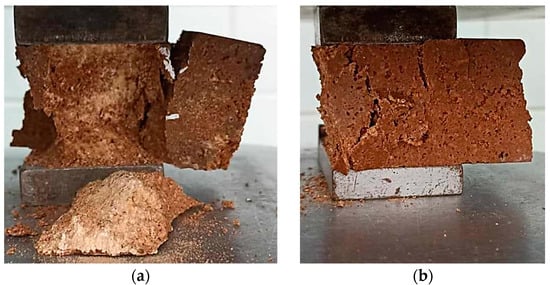
Figure 15.
Failure modes of the test specimens in compression: (a) brittle failure of unfibered composite and (b) ductile failure of fiber composite.
Figure 15a (unfibered composite) reveals the presence of cracks that progressively widen with increasing applied load, extending at a 45° angle throughout the full height of the specimen. This failure mechanism exhibits inherent brittleness, characterized by the absence of discernible plastic deformation. Nevertheless, fiber composites exhibit a failure mode characterized by the formation of vertical or interlaminar cracks, as illustrated in Figure 15b. In contrast to non-fibered composites, they demonstrate a more ductile response when subjected to compressive loading conditions. This enhanced ductility can be attributed to the plant fibers’ capacity to inhibit crack formation and promote plastic deformation within the material.
3.3.2. In Bending Tensile Test
The failure modes observed during the bending tests (Figure 16) affirm the positive influence of fibers in general, and more specifically, jute fibers. In the case of the non-fiber composite, a brittle fracture occurs, resulting in the separation of the two halves of the tested specimen (Figure 16a). Conversely, a ductile fracture characterized by cracking without the separation of the two broken specimen parts is evident (Figure 16a,b). The extent of crack propagation is notably reduced in composites reinforced with jute fibers compared to those reinforced with date palm fibers.

Figure 16.
The failure modes in bending tensile test of (a) unfibered composite, (b) composite reinforced with date palm fiber and (c) composite reinforced with jute fiber.
3.3.3. Fracture Facies in Bending Test
In the case of jute fibers, perfect adhesion between the flexible jute fibers and the earth–resin matrix was observed (Figure 17a). Simultaneous rupture of the composite and the individual fibers occurred, notably without any discernible fiber tearing. This cohesive failure mode can be attributed to the robust adhesion between the jute fibers and the matrix. The strong interfacial bonding ensures effective load transfer between the fibers and the matrix, resulting in a coherent and simultaneous rupture of both components.

Figure 17.
Fracture facies in bending test of (a) composite reinforced with jute fiber; (b) composite reinforced with date palm fiber and (c) unfibered composite.
Conversely, a contrasting scenario unfolds when examining composites reinforced with date palm fibers (Figure 17b). In this case, rupture predominantly takes the form of fiber tearing, indicating weaker adhesion at the fiber–matrix interface. This diminished adhesion allows for the initiation of debonding between the date palm fibers and the matrix, subsequently leading to the tearing of individual fibers.
Shifting our focus to the unfibered composite and the presence of pores (Figure 17c), a distinct mechanism comes into play. These pores result from voids created by the displacement of sand gravel within the clayey soil, ultimately giving rise to a brittle fracture mechanism characterized by deflection. The pores serve as stress concentrators, exacerbating the initiation and propagation of fractures within the composite.
3.4. Scanning Electron Microscope (SEM) Observations
The images obtained through scanning electron microscopy (SEM), as depicted in Figure 18, substantiate the observations concerning facies fractures. Figure 18a clearly demonstrates that composites reinforced with jute fibers are characterized by flawless adhesion between the fibers and the matrix, facilitated by the presence of microfibrils within the jute fibers. Additionally, Figure 18b highlights a relatively feeble bond at the interface between the earth–resin composite matrix and the date palm fibers, attributable to the smooth surface of the latter. It is worth emphasizing that the impression of the sand particles on the unfibered composite is distinctly recognizable (Figure 18c).
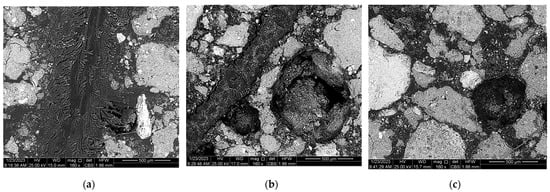
Figure 18.
SEM observations of (a) composite reinforced with jute fiber, (b) composite reinforced with date palm fiber and (c) unfibered composite.
3.5. Influence on the Surface Properties of Composites by the Vickers Indentation Test
The indentation test serves as a crucial tool for comprehending the intricate mechanical properties and underlying mechanisms contributing to the fragility of the composites under investigation. In this study, we systematically assessed the elastic modulus (E) and Vickers hardness (VHN) of these composites, employing the highly precise microhardness testing technique. Table 4 presents the results of the Vickers indentation test on the studied composites.

Table 4.
Results of the Vickers indentation test on the studied composites.
The strength–displacement curves obtained from the micro-indentation experiments (Figure 19) manifest a distinct sequence of events: an initial loading phase, followed by a 15 s period of maintaining the maximum force at 2N and, subsequently, an unloading phase until reaching the zero-displacement point. Importantly, this unloading phase reveals the remarkable elastic recovery of the material, from which the initial slope is diligently employed to deduce the elastic indentation modulus. Significantly, the hysteresis prominently observed in these curves unequivocally signifies the dissipation of energy, unequivocally characterizing the studied fiber composites as displaying ductile behavior.
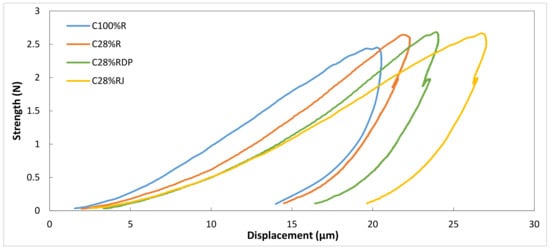
Figure 19.
The strength–displacement curves of the micro-indentation test.
Upon analysis of the obtained fingerprint data (Figure 20), it became evident that the four types of composites under investigation exhibited distinct behaviors. Specifically, the behavior of the 100% resin reference material was characterized by a prominently visible imprint that expanded in size as the indentation force increased. In the vicinity of the indentation, we observed the presence of slip lines indicating irreversible deformation. In contrast, the remaining composites presented a footprint that proved challenging to quantify due to disruptions caused by the indenter’s contact with the plant fibers.

Figure 20.
Fingerprint data obtained from the indentation test of the composites: (a) unfibered composite C100%R, (b) unfibered composite C100%R, (c) fibered composite C28%RJ and (d) fibered composite C28%RDP.
4. Conclusions
In this study, the feasibility of a natural composite created from a clay-sand mixture reinforced with plant fibers (date palm and jute) and bonded using a polymer resin polyester was explored. The significant findings include:
- Variations in fiber mass concentrations and lengths led to alterations in porosity and density;
- Increasing fiber content and length substantially enhanced mechanical properties, particularly strength and flexibility;
- The composite maintains cost-effectiveness and eco-friendliness, with porosity having no adverse impact on its mechanical performance;
- Jute fibers exhibited superior adhesion to the earth–resin matrix;
- The optimal composite formulation comprises 28% polyester resin and 2% fibers with 1 cm, preferably jute, demonstrating ductility and robust mechanical characteristics;
- This innovative composite has the potential to replace cement-based materials across various applications, including structural rehabilitation, decoration, wall cladding, and more;
- These findings contribute to the development of environmentally sustainable and structurally efficient construction practices, heralding a promising future for construction and rehabilitation.
5. Future Work
It is worth pointing out that through resin stabilization, the composite undergoes a transformation from hydrophilic to hydrophobic, and such processes need to be considered and investigated in future works.
Author Contributions
Conceptualization, S.M. and M.B.; methodology, M.S. and M.K.; writing—original draft preparation, S.M. and M.B; writing—review and editing, M.S., Y.H. and M.B.; visualization, Y.H., F.S., N.G. and S.R.-B.; supervision, R.B. and M.K.; project administration, M.S. All authors have read and agreed to the published version of the manuscript.
Funding
This research received no external funding.
Data Availability Statement
The data presented in this study are available on request from the corresponding authors.
Acknowledgments
The authors extend their appreciation to the School of Energy, Construction and Environment, Coventry University, UK, to National Higher School of Technology and Engineering-Annaba (ENSTI-Annaba) and to Annaba Foundry Laboratory (LRF-Annaba) Department of Metallurgy, Annaba University, for the use of their lab facilities.
Conflicts of Interest
The authors declare no conflict of interest.
References
- Kebaili, B.; Benzerara, M.; Menadi, S.; Kouider, N.; Belouettar, R. Effect of Parent Concrete Strength on Recycled Concrete Performance. Frat. Ed Integrità Strutt. 2022, 16, 14–25. [Google Scholar] [CrossRef]
- Benzerara, M.; Biskri, Y.; Saidani, M.; Slimani, F.; Belouettar, R. High-Temperature Behavior of Polyethylene-Terephthalate-Fiber-Reinforced Sand Concrete: Experimental Investigation. Fibers 2023, 11, 46. [Google Scholar] [CrossRef]
- Žarković, M.; Lakić, S.; Ćetković, J.; Pejović, B.; Redzepagic, S.; Vodenska, I.; Vujadinović, R. Effects of Renewable and Non-Renewable Energy Consumption, GHG, ICT on Sustainable Economic Growth: Evidence from Old and New EU Countries. Sustainability 2022, 14, 9662. [Google Scholar] [CrossRef]
- Kalak, T. Potential Use of Industrial Biomass Waste as a Sustainable Energy Source in the Future. Energies 2023, 16, 1783. [Google Scholar] [CrossRef]
- Moshood, T.D.; Nawanir, G.; Mahmud, F.; Mohamad, F.; Ahmad, M.H.; AbdulGhani, A. Sustainability of Biodegradable Plastics: New Problem or Solution to Solve the Global Plastic Pollution? Curr. Res. Green Sustain. Chem. 2022, 5, 100273. [Google Scholar] [CrossRef]
- Rahim, O.; Achoura, D.; Benzerara, M.; Bascoulès-Perlot, C. Experimental Contribution to the Study of the Physic-Mechanical Behavior and Durability of High-Performance Concretes Based on Ternary Binder (Cement, Silica Fume and Granulated Blast Furnace Slag). Frat. Ed Integrità Strutt. 2021, 16, 344–358. [Google Scholar] [CrossRef]
- Bourbia, S.; Kazeoui, H.; Belarbi, R. A Review on Recent Research on Bio-Based Building Materials and Their Applications. Mater. Renew. Sustain. Energy 2023, 12, 117–139. [Google Scholar] [CrossRef]
- Marczak, D.; Lejcuś, K.; Kulczycki, G.; Misiewicz, J. Towards Circular Economy: Sustainable Soil Additives from Natural Waste Fibres to Improve Water Retention and Soil Fertility. Sci. Total Environ. 2022, 844, 157169. [Google Scholar] [CrossRef]
- Biskri, Y.; Benzerara, M.; Babouri, L.; Dehas, O.; Belouettar, R. Valorization and Recycling of Packaging Belts and Post-Consumer PET Bottles in the Manufacture of Sand Concrete. Frat. Ed Integrità Strutt. 2022, 16, 225–239. [Google Scholar] [CrossRef]
- Aboutair, W.; Chaid, R.; Perrot, A. Impact of the Nature of Fibers on the Physicomechanical Behavior and Durability of Cement Matrices. Iran. J. Sci. Technol. Trans. Civ. Eng. 2021, 45, 1467–1482. [Google Scholar] [CrossRef]
- Fattahi, M.; Taban, E.; Soltani, P.; Berardi, U.; Khavanin, A.; Zaroushani, V. Waste Corn Husk Fibers for Sound Absorption and Thermal Insulation Applications: A Step towards Sustainable Buildings. J. Build. Eng. 2023, 77, 107468. [Google Scholar] [CrossRef]
- Erdogmus, E. Use of Fiber-Reinforced Cements in Masonry Construction and Structural Rehabilitation. Fibers 2015, 3, 41–63. [Google Scholar] [CrossRef]
- Medina-Martinez, C.J.; Sandoval Herazo, L.C.; Zamora-Castro, S.A.; Vivar-Ocampo, R.; Reyes-Gonzalez, D. Use of Sawdust Fibers for Soil Reinforcement: A Review. Fibers 2023, 11, 58. [Google Scholar] [CrossRef]
- Lourenço, P.B.; Ciocci, M.P.; Greco, F.; Karanikoloudis, G.; Cancino, C.; Torrealva, D.; Wong, K. Traditional Techniques for the Rehabilitation and Protection of Historic Earthen Structures: The Seismic Retrofitting Project. Int. J. Archit. Herit. 2019, 13, 15–32. [Google Scholar] [CrossRef]
- Costa, C.S.; Rocha, F.; Velosa, A.L. Sustainability in Earthen Heritage Conservation. Geol. Soc. Lond. Spec. Publ. 2016, 416, 91–100. [Google Scholar] [CrossRef]
- Benzerara, M.; Guihéneuf, S.; Belouettar, R.; Perrot, A. Combined and Synergic Effect of Algerian Natural Fibres and Biopolymers on the Reinforcement of Extruded Raw Earth. Constr. Build. Mater. 2021, 289, 123211. [Google Scholar] [CrossRef]
- Sellami, A. Elaboration Des Composites Cimentaires à Base de Fibres Végétales Locales (Le Diss): Caractérisation, Durabilité et Application Au Cas de La Maçonnerie. Ph.D. Thesis, Université Badji Mokhtar Annaba, Annaba, Algeria, 2015. [Google Scholar]
- Terki, Y.; Rakotomamonjy, B.; Hacini, M.; Benhachmi, T.; Henous, M.; Belouaar, A.; Eldjouzi, A.; Moriset, S.; Okbaoui, C.; Almama, A.; et al. Guide de Réhabilitation de l’habitat En Terre à Timimoun. Ph.D. Thesis, CRAterre, Villefontaine, France, 2019. [Google Scholar]
- Ardant, D.; Brumaud, C.; Perrot, A.; Habert, G. Robust Clay Binder for Earth-Based Concrete. Cem. Concr. Res. 2023, 172, 107207. [Google Scholar] [CrossRef]
- Mabrouk, Y.; Benazzouk, A.; Lahmar, A.; Azrour, M.; Mocerino, C.; Lahmar, A. Elaboration and Characterization of Lightweight Rammed Earth Containing Hemp Particles. Mater. Today Proc. 2022, 58, 1389–1396. [Google Scholar] [CrossRef]
- Tarhan, Y.; Perrot, A. Reinforcement of 3D Printable Earth-Based Mortar with Natural Textile Material. Mater. Today Proc. 2023, S2214785323043080. [Google Scholar] [CrossRef]
- Nurazzi, N.M.; Asyraf, M.R.M.; Khalina, A.; Abdullah, N.; Aisyah, H.A.; Rafiqah, S.A.; Sabaruddin, F.A.; Kamarudin, S.H.; Norrrahim, M.N.F.; Ilyas, R.A.; et al. A Review on Natural Fiber Reinforced Polymer Composite for Bullet Proof and Ballistic Applications. Polymers 2021, 13, 646. [Google Scholar] [CrossRef]
- Palanikumar, K.; Natarajan, E.; Markandan, K.; Ang, C.K.; Franz, G. Targeted Pre-Treatment of Hemp Fibers and the Effect on Mechanical Properties of Polymer Composites. Fibers 2023, 11, 43. [Google Scholar] [CrossRef]
- Abbass, A.; Paiva, M.C.; Oliveira, D.V.; Lourenço, P.B.; Fangueiro, R. Insight into the Effects of Solvent Treatment of Natural Fibers Prior to Structural Composite Casting: Chemical, Physical and Mechanical Evaluation. Fibers 2021, 9, 54. [Google Scholar] [CrossRef]
- Bahar, A.; Hamami, A.E.A.; Benmahiddine, F.; Belhabib, S.; Belarbi, R.; Guessasma, S. The Thermal and Mechanical Behaviour of Wood-PLA Composites Processed by Additive Manufacturing for Building Insulation. Polymers 2023, 15, 3056. [Google Scholar] [CrossRef] [PubMed]
- Bekkouche, S.R.; Benzerara, M.; Zada, U.; Muhammad, G.; Ali, Z. Use of Eco-Friendly Materials in the Stabilization of Expansive Soils. Buildings 2022, 12, 1770. [Google Scholar] [CrossRef]
- NF EN ISO 17892-4; Reconnaissance et Essais Géotechniques—Essais de Laboratoire Sur Les Sols—Partie 4: Détermination de La Distribution Granulométrie Des Particules. European Standard AFNOR: Paris, French, 2018.
- NF EN ISO 17892-3; Reconnaissance et Essais Géotechniques—Essais de Laboratoire Sur Les Sols—Partie 3: Détermination de La Masse Volumique Des Particules Solides. European Standard AFNOR: Paris, France, 2015.
- NF EN ISO 17892-5; Reconnaissance et Essais Géotechniques—Essais de Laboratoire Sur Les Sols—Partie 5: Essai de Chargement Par Palier à l’œdomètre. European Standard AFNOR: Paris, France, 2017.
- NF EN ISO 17892-1; Reconnaissance et Essais Géotechniques—Essais de Laboratoire Sur Les Sols—Partie 1: Détermination de La Teneur En Eau. European Standard AFNOR: Paris, France, 2014.
- NF EN ISO 17892-10; Reconnaissance et Essais Géotechniques—Essais de Laboratoire Des Sols—Partie 10: Essai de Cisaillement Direct. European Standard AFNOR: Paris, France, 2018.
- NF P94-068; Sols: Reconnaissance et Essais—Mesure de La Capacité d’adsorption de Bleu de Méthylène d’un Sol Ou d’un Matériau Rocheux—Détermination de La Valeur de Bleu de Méthylène d’un Sol Ou d’un Matériau Rocheux Par l’essai à La Tache. European Standard AFNOR: Paris, France, 1998.
- NF EN ISO 17892-12; Reconnaissance et Essais Géotechniques—Essais de Laboratoire Sur Les Sols—Partie 12: Détermination Des Limites de Liquidité et de Plasticité. European Standard AFNOR: Paris, France, 2018.
- NF EN 13925-1; Essais Non Destructifs—Diffraction Des Rayons X Appliquée Aux Matériaux Polycristallins et Amorphes—Partie 1: Principes Généraux. European Standard AFNOR: Paris, France, 2003.
- NF ISO 10390; Qualité Du Sol—Détermination Du pH. European Standard AFNOR: Paris, France, 2005.
- Boutarfa, M.; Belouettar, R.; Makradi, A. Comparative Study of Cement Mortar Reinforced with Vegetable Fibers Alfa, Date Palm and Diss: Mechanical Properties and Shrinkage. J. Mater. Environ. Sci. 2018, 9, 2304–2314. [Google Scholar]
- Derdour, D.; Behim, M.; Benzerara, M. Effect of Date Palm and Polypropylene Fibers on the Characteristics of Self-Compacting Concretes: Comparative Study. Frat. Ed Integrità Strutt. 2023, 17, 31–50. [Google Scholar] [CrossRef]
- Mirouzi, G.; Redjel, B.; Jauberthie, R. Formulation et comportement mécanique de micro-bétons à matrice de résine polyester. Nat. Technol. 2013, 9, 19–27. [Google Scholar]
- NF EN 12390-1; Essai Pour Béton Durci-Partie 1: Forme, Dimensions et Autres Éxigences Relatives Aux Éprouvettes et Aux Moules. European Standard AFNOR: Paris, France, 2001.
- NF EN 12390-5; Essai Pour Béton Durci, Partie5: Résistance à La Flexion Sur Éprouvette. European Standard AFNOR: Paris, France, 2019.
- NF EN 12390-3; Essai Pour Béton Durci, Partie 3: Résistance à La Compression Sur Éprouvette. European Standard AFNOR: Paris, France, 2000.
- Assala, O.; Fellah, M.; Mechachti, S.; Touhami, M.Z.; Khettache, A.; Bouzabata, B.; Weiβ, H.; Jiang, X. Preparation and Characterisation of Diamond-like Carbon Films Prepared by MW ECR/PACVD Process Deposited on 41Cr–Al–Mo7 Nitrided Steel. Trans. IMF 2018, 96, 145–154. [Google Scholar] [CrossRef]
- NF EN ISO 6507-1; Matériaux Métalliques—Essai de Dureté Vickers—Partie 1: Méthode d’essai. European Standard AFNOR: Paris, France, 2018.
- NF EN ISO 14577-1; Matériaux Métalliques—Essai de Pénétration Instrumenté Pour La Détermination de La Dureté et de Paramètres Des Matériaux—Partie 1: Méthode d’essai. European Standard AFNOR: Paris, France, 2015.
Disclaimer/Publisher’s Note: The statements, opinions and data contained in all publications are solely those of the individual author(s) and contributor(s) and not of MDPI and/or the editor(s). MDPI and/or the editor(s) disclaim responsibility for any injury to people or property resulting from any ideas, methods, instructions or products referred to in the content. |
© 2023 by the authors. Licensee MDPI, Basel, Switzerland. This article is an open access article distributed under the terms and conditions of the Creative Commons Attribution (CC BY) license (https://creativecommons.org/licenses/by/4.0/).